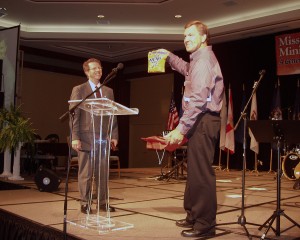By Franklin R. Dumond
When Van Halen’s rock concerts expanded to new markets, Article 126 was added to their production contract. This obscure instruction was buried among all the details of weight limits, rigging points and door widths required to bring in, set up and operate the several truckloads of equipment and staging used in the concert.
 Article 126 seemed odd, even unnecessary. It simply required that backstage should be equipped with a bowl of M&M candies. The stipulation continued that all brown M&M’s be removed. Even a single brown M&M could result in forfeiture of the show with full compensation paid to the band by the promoters.
Article 126 seemed odd, even unnecessary. It simply required that backstage should be equipped with a bowl of M&M candies. The stipulation continued that all brown M&M’s be removed. Even a single brown M&M could result in forfeiture of the show with full compensation paid to the band by the promoters.
At least one concert was cancelled when brown M&M’s were discovered. The appearance of a brown piece of candy indicated to the band that other contract requirements had probably not been followed. At the cancelled concert, local promoters had not only allowed brown candy, but had also failed to read the weight requirements for staging and equipment. If the concert had not been cancelled the arena’s stage would have collapsed under the weight of the equipment needed for the production. (See Crazy from the Heat by David Lee Roth)
We don’t usually serve M&M’s while doing ministry, but there are at least five little things that when left unattended can be red flags of danger. These red flags may signal imminent decline or even impending death of once thriving churches.
1. Dust and Clutter It happens so gradually that regular attenders become accustomed to it while guests cringe. It is especially distasteful when it happens in restrooms, foyer areas and kitchens. One solution to this might be a good spring cleaning day or fall workday with specific lists of areas to be cleaned and items to be stored properly.
2. Spelling Errors This used to be confined to the weekly bulletin that was hurriedly composed in preparation for Sunday. Word processors have eliminated many of those glaring errors while also introducing the new peril of a correctly spelled word that is the wrong one. (i.e. ‘the’ when ‘they’ was the intended word) Projection systems also introduce a new arena for error since song lyrics and announcements tend to be saved for future use. Unfortunately first time errors will not be corrected by merely saving the work for second time use. Two solutions here include having every printed piece read by at least two people and having someone make a list of projected errors so they can be corrected.
3. Inadequate Signage Even small buildings benefit from a few well-placed directional signs. Restrooms and nurseries should be easily located. Children’s areas, especially if the church invests in extended children’s worship/ministries, should be identified. A possible way to identify signage needs might be to ask a friend to visit the building for the first time and then report how easy or difficult it was to find needed areas based on the available signage.
4. Dated Color Schemes While some colors and décor remain classic others change with every generation. Classic architecture and genuine antique furnishings never go out of style if properly maintained, while the pastels of the 70s and the heavy earthen tones of the 80s have been replaced by new preferences. Glaring fluorescent tubes may be easily replaced with fixtures that use even less energy while producing a more natural light. A solution to this issue might be to look back to when the church was last repainted or redecorated, and to determine a schedule of revisiting décor at least every 5-7 years.
5. Light Bulbs and Trash Cans While possibly an extension of dust and clutter this area warrants a separate listing. If light bulbs are burned out and trash cans are full urgent attention is required. In a recent visit to a church I almost asked where the janitor’s closet was located because I counted so many light fixtures that needed new bulbs! The only solution to this red flag is for someone to take the time to change the bulbs and empty the trash cans!
While this list may seem a little silly, or even inconsequential, it has been my experience that a church that does not give attention to these little things will not give attention to the big things of missions and evangelism and discipleship.
What little things have you noticed that, when left unattended, become major things? Click “Leave a Comment” at the top of this article to share your experiences with us.


